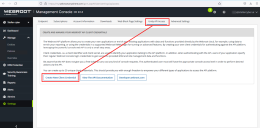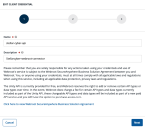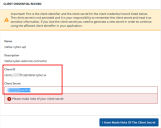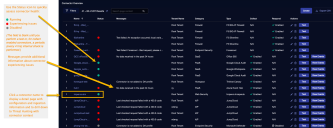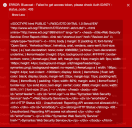Configuring Webroot Connectors
This connector allows Stellar Cyber to ingest logs from Webroot and add the records to the data lake.
Stellar Cyber connectors with the Collect function (collectors) may skip collecting some data when the ingestion volume is large, which potentially can lead to data loss. This can happen when the processing capacity of the collector is exceeded.
Connector Overview: Webroot
Capabilities
-
Collect: Yes
-
Respond: No
-
Native Alerts Mapped: No
-
Runs on: DP
-
Interval: Configurable
Collected Data
|
Content Type |
Index |
Locating Records |
|---|---|---|
|
Blocked Urls Blocked Traffic Endpoints Phishing Threat History Traffic Summary |
Syslog |
Domain
|
https://unityapi.webrootcloudav.com |
Response Actions
N/A
Third Party Native Alert Integration Details
N/A
Required Credentials
-
Client ID, Client Secret, Username, Password, Parent Keycode (GSM key)
Let us know if you find the above overview useful.
Adding a Webroot Connector
To add a Webroot connector:
Obtaining Webroot Credentials
Use the following steps as a guide to obtain the credentials required to allow Stellar Cyber to retrieve data with the Webroot API.
-
Access the Webroot Identity Portal (Management Console) as the username and password you will use to configure the Stellar Cyber connector. Make note of the login information for later use.
The password should not include non-ASCII special characters.
-
From the left navigation pane, select Settings.
-
When the Settings page displays, select the Unity API Access sub-tab.
-
Click the button to Create New Client Credential.
-
In the dialog that displays, specify a Name and Description for the credential, then click Next.
-
On the next screen, enable the option to use the event notification API, specifying Other use ... for the Purpose. Then click Next.
-
On the final screen, click Save.
-
The console displays a dialog with both the Client ID and the Client Secret. Make note of both of these values. The Client Secret cannot be retrieved later, although it can be regenerated.
- The final information you need is the Parent Keycode, which you will enter as the GSM Key later. Click the sub-tab for Account Information and record the value for that field.
-
Review your list of information before proceeding. You should now have:
-
Username
-
Password
-
Client ID
-
Client Secret
-
Parent Keycode (GSM key)
-
Adding the Connector in Stellar Cyber
With the access information handy, you can add a Webroot connector in Stellar Cyber:
-
Log in to Stellar Cyber.
-
Click System | Integration | Connectors. The Connector Overview appears.
-
Click Create. The General tab of the Add Connector screen appears. The information on this tab cannot be changed after you add the connector.
The asterisk (*) indicates a required field.
-
Choose Endpoint Security from the Category drop-down.
-
Choose Webroot from the Type drop-down.
-
For this connector, the supported Function is Collect, which is enabled already.
-
Enter a Name.
This field does not accept multibyte characters.
-
Choose a Tenant Name. This identifies which tenant is allowed to use the connector.
-
Choose the device on which to run the connector.
-
(Optional) When the Function is Collect, you can create Log Filters. For information, see Managing Log Filters.

-
Click Next. The Configuration tab appears.
The asterisk (*) indicates a required field.
-
Enter the following information you noted from the previous section:
-
Enter the Client ID.
-
Enter the Client Secret.
-
Enter the Username and Password.
-
Enter the GSM Key (Parent Keycode).
-
-
Choose the Interval (min). This is how often the logs are collected.
-
Chose the Content Type. The following are available:
-
Blocked Urls
-
Blocked Traffic
-
Endpoints
-
Phishing
-
Threat History
-
Traffic Summary
-
-
Click Next. The final confirmation tab appears.
-
Click Submit.
To pull data, a connector must be added to a Data Analyzer profile if it is running on the Data Processor.
The new connector is immediately active.
Testing the Connector
When you add (or edit) a connector, we recommend that you run a test to validate the connectivity parameters you entered. (The test validates only the authentication / connectivity; it does not validate data flow).
For connectors running on a sensor, Stellar Cyber recommends that you allow 30-60 seconds for new or modified configuration details to be propagated to the sensor before performing a test.
-
Click System | Integrations | Connectors. The Connector Overview appears.
-
Locate the connector that you added, or modified, or that you want to test.
-
Click Test at the right side of that row. The test runs immediately.
Note that you may run only one test at a time.
Stellar Cyber conducts a basic connectivity test for the connector and reports a success or failure result. A successful test indicates that you entered all of the connector information correctly.
To aid troubleshooting your connector, the dialog remains open until you explicitly close it by using the X button. If the test fails, you can select the button from the same row to review and correct issues.
The connector status is updated every five (5) minutes. A successful test clears the connector status, but if issues persist, the status reverts to failed after a minute.
Repeat the test as needed.
Resolving Error Messages for Webroot Connectors
In certain situations, the initial Test for a Webroot connector may report success but then subsequently display an error message in the Messages column of the System | Connectors page. Use the following information to resolve common error messages for Webroot connectors:
-
WSAT is not enabled for this site"{"statusCode":400,"requestId":"c60683f4-09a7-48c2-ae48-c8df21e8bb90","error":"wsat_not_enabled","error_description":"WSAT is not enabled for this site.","AdditionalInformation":{}}"This error message appears when the Security Awareness Training feature in Webroot is either not enabled or its subscription has expired. Try the following in Webroot:
-
Make sure that WSAT is enabled in Security Awareness Training | Settings | Enable Security Awareness Training.
-
Make sure the Security Awareness subscription has not expired.
-
-
DNSP is not enabled for this site{"statusCode":400,"requestId":"0e12a84d-1123-4c87-937b-a6469ee52b3c","error":"dnsp_not_enabled","error_description":"DNSP is not enabled for this site.","AdditionalInformation":{}}This error message appears when the DNS Protection feature in Webroot is either not enabled or its subscription has expired. Try the following in Webroot:
-
Make sure that the DNS Protection subscription in Webroot is not expired.
-
Make sure that the DNS Protection feature is set to On in Webroot.
-
Verifying Ingestion
To verify ingestion:
- Click Investigate | Threat Hunting. The Interflow Search tab appears.
- Change the Indices to Syslog. The table immediately updates to show ingested Interflow records.
